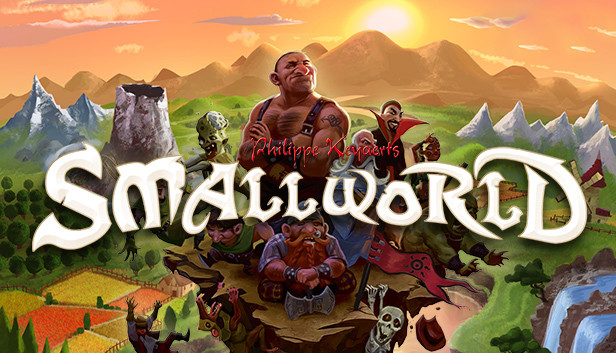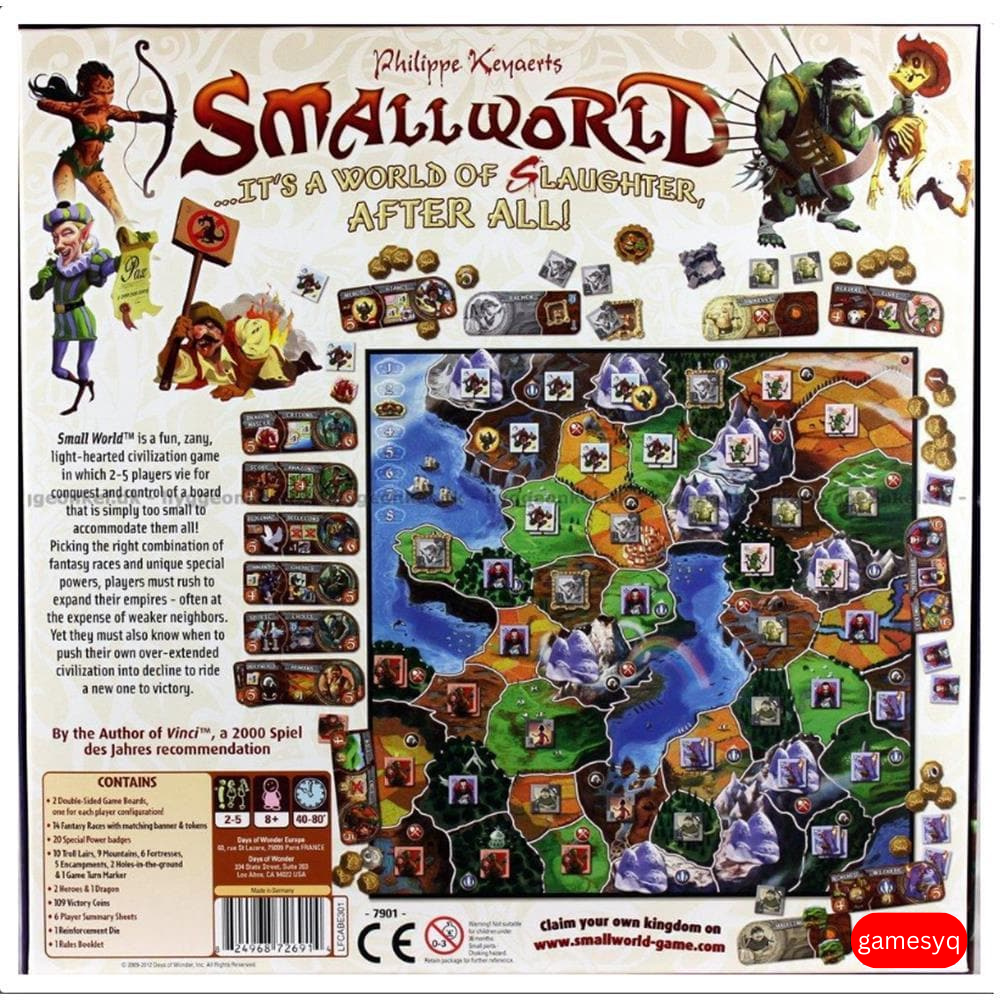
I intend to commence my Days of Wonder collection with an evaluation of Small World.
In Smallworld, the world is too small to accommodate all of the different races (to ensure this mechanic remains true, a different map is utilized for each player count). Active players have the following options on any given turn: 1) select a new active race and expand using it if none is currently active; 2) expand using their active race; or 3) place their active race into decline. They can accumulate victory points contingent on the number of territories (and incentives) held by their declined race and their active race, following their turn.
Now that you have a basic understanding of the game, the following are several aspects in which it excels.
The game is scalable. As previously stated, the map utilized in a game is proportional to the number of participants. This facilitates the game’s enjoyment for two to five participants.
The game also requires considerable strategy regarding 1) which race to select and 2) how to utilize that race. 3) the Target of the assault and 4) the Opponent to be targeted.
Additionally, the game is incredibly simple to master. This game’s battle mechanic, among other play mechanics, enables novice players to commence their experience with minimal effort.
Smallworld is rated an overall 8.0/10. Similar to every Day of Wonder game I have encountered thus far, this one is unquestionably enjoyable to play; however, its lack of replayability prevented it from earning a score in the 9.0 range.

Consider Shadows Over Camelot, Pirate’s Cove (one of my favorites), and Mystery Express if you enjoy Days of Wonder titles.
Simply put, what purpose does all that cardboard serve?
Small World is set on a map that, appropriately, is insufficient in size to accommodate all the races competing for territorial dominance. In this area of control conflict, prototypical fantasy races compete against one another. Every race possesses a unique set of strengths and is enhanced by a special ability that facilitates its struggle for supremacy. During play, these pairings are disclosed in a running sequence; this represents merely one facet of cardboard maintenance.
Each race, upon selection, is provided with a set of tokens to be utilized on the board. The battle mechanism is extremely straightforward. To defeat a territory on the map, players are required to position two tokens in addition to one for each token that is already present. Mountain ranges, lairs, or encampments that offer additional protection to one of the races could constitute these additional tokens.
The majority of player turns are spent positioning tokens until there are no more to win. Providing they possess a minimum of one unused token, the player may now cast a die to determine whether or not they require reinforcements to complete their final attempted conquest. After the conflict has concluded, players may reallocate their tokens to reinforce weaker territories before acquiring a Victory token for every occupied territory.
In each occupied territory, players may place a race into decline by tossing a single token to its shadowy reverse, signifying their intention to choose a new race-power alliance in the subsequent round, when the race has become fragile and ravaged by war. In addition to their active race, each player may have one declining race on the board, which accumulates Victory tokens until it is eliminated.
These are, with a few exceptions how tokens enter and exit the board, how the different territory categories benefit particular races and powers, and so forth the fundamental aspects of Small World. A constant barrage of cardboard activity bombards at every turn. The number of competitors may vary, but eight to ten bouts are adequate to determine the victor.
For more than fourteen years, Small World has developed into an independent retail commonwealth. Numerous power packs and full-fledged expansions provide access to dozens of competitions, catering to both enthusiasts and novices. Phenomenal video game collaborations, horror, legends, air, and sea, encounter one another, each utilizing their own set of chits and tokens. If I were endowed with the financial means and the time to do so, I would gladly empty each organizer tray of every component to determine what manner of mass inhabits this franchise.
However, as stated initially, it is robust. I possess solely the basic game. Despite the abundance of pieces, I truly enjoy Small World due to its relative simplicity, even though we only play it a handful of times per year.
The battle becomes exceedingly user-friendly when the fundamental skill required is the ability to count to six or seven. If an opposing team loses a sufficient number of tokens, they will remove their equipment and return home. Although one defeated token is removed from the board, the fact that there is theoretical room to retreat to safety after the turn is greatly appreciated.
The sole exception to the instantaneous nature of battles is the inclusion of dice and randomness at the conclusion. By its simplicity, the dynamic board state becomes the focal point of the experience. Such flux leaves no room for sentimentality.
This ease of preparation inspired confidence in me to invite my small daughter to the table. The interaction between the map and the races, determining the optimal way to branch out, when to enter decline, and how to assess the state of the board, undoubtedly, involve a great deal more. However, she could undoubtedly traverse the map on foot with her Alchemist Skeletons.
After I clarified that she receives additional skeletons as compensation for conquering territories as opposed to staking empty ones, she gained sufficient comprehension to begin selecting individuals. She maintained control of those Skeletons for seven rounds and finished in the top four (among four players), proving that Small World can be played with relative ease by anyone.
However, for those with a more strategic mindset, Small World also provides some substantial value. It requires some cognitive effort to decipher the opportunities presented on the map, the possibilities inherent in the race-power pairings, and the intentions of the other players at the table.
When and how frequently to decline is a crucial factor in generating passive income. In contrast, area skirmishes are characterized by dispassionate calculation rather than chance, due to the limited utilization of die rolls. Because participants are not acting by chance, victory feels like a triumph.

Despite being constrained by the fourteen folk types and twenty unique powers of the basic game, the random combinations provide a healthy amount of variation between games. Boxed player aids featuring comprehensive descriptions of all races and powers, as well as game details, are available.
These aids are of great assistance until the iconography becomes clear. Having a pair of two-sided boards featuring unique maps for each player count ensures that each excursion is also a little bit more unique. The innumerable variations available in the market are intellectually taxing to contemplate. If you have an interest in the gameplay, “World of Slaughter” is unlikely to become tedious.
To maintain order, the greatest portion of the cardboard—168 race tokens—is quite well-organized in a molded tray. Although that order requires exertion, it remains order. The greatest inconvenience is caused by the fact that the Victory tokens are stored in four compartments within the insert.
Replacing them after removing them is a tedious process. Coin slots, in general, are not my preferred insert feature in any game (Camel Up, I’m staring at you). Nonetheless, the insert is beneficial overall. I make fun of the abundant cardboard while nodding and winking.
Small World fluctuates in tandem with my family. I have yet to contemplate bartering it away, as we occasionally return and derive pleasure from one or two battles. Seeing as our youngest now understands the fundamental mechanics, I can envision her requesting “that little world game” more frequently.
We derive great pleasure from its release. Although there are indeed times when we merely fail to notice its presence, Keyaerts’s design has consistently produced satisfactory results ever since the days of Leonardo da Vinci. The artwork of Miguel Coimbra and Cyrille Daujean has fared better than that of many of its pre-2010 contemporaries, even though the game is now an adolescent. As I have previously stated, it is reliable.
